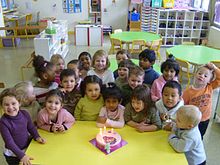This is an old revision of this page, as edited by Gilabrand (talk | contribs) at 16:16, 20 July 2010. The present address (URL) is a permanent link to this revision, which may differ significantly from the current revision.
Revision as of 16:16, 20 July 2010 by Gilabrand (talk | contribs)(diff) ← Previous revision | Latest revision (diff) | Newer revision → (diff) This article is about the human "child". For other uses, see Child (disambiguation).
A child (plural: children) is a human being between the stages of birth and puberty. The legal definition of "child" generally refers to a minor, otherwise known as a person younger than the age of majority. "Child" may also describe a relationship with a parent or authority figure, or signify group membership in a clan, tribe, or religion; it can also signify being strongly affected by a specific time, place, or circumstance, as in "a child of nature" or "a child of the Sixties."
Legal and biological definitions

The United Nations Convention on the Rights of the Child defines a child as "a human being below the age of 18 years unless under the law applicable to the child, majority is attained earlier." Ratified by 192 of 194 member countries. Biologically, a child is anyone between birth and puberty or in the developmental stage of childhood, between infancy and adulthood.
Attitudes toward children
Social attitudes toward children differ around the world in various cultures. These attitudes have changed over time. A 1988 study on European attitudes toward the centrality of children found that Italy was more child-centric and Holland less child-centric, with other countries, such as Austria, Great Britain, Ireland and West Germany falling in between.
Age of responsibility

The age at which children are considered responsible for their own actions (e.g., marriage, voting, etc.) has also changed over time, and this is reflected in the way they are treated in courts of law. In Roman times, children were regarded as not culpable for crimes, a position later adopted by the Church. In the nineteenth century, children younger than seven years old were believed incapable of crime. Children from the age of seven forward were considered responsible for their actions. Therefore, they could face criminal charges, be sent to adult prison, and be punished like adults by whipping, branding or hanging.
Surveys have found that at least 25 countries around the world have no specified age for compulsory education. Minimum employment age and marriage age also vary. In at least 125 countries, children aged 7–15 may be taken to court and risk imprisonment for criminal acts. In some countries, children are legally obliged to go to school until they are 14 or 15 years old, but may also work before that age. A child's right to education is threatened by early marriage, child labour and imprisonment.
Further information: Age of consent, Age of majority, Age of criminal responsibility, and Marriageable ageSocialization of the child

All children go through stages of social development. An infant or very young child will play alone happily. If another child wanders onto the scene, he or she may be physically attacked or pushed out of the way. Next, the child is able to play with another child, gradually learning to share and take turns. Eventually the group grows larger, to three or four children. By the time a child enters kindergarten, he or she is usually able to join in and enjoy group experiences.
Children with ADHD and learning disabilities may need extra help in developing social skills. The impulsive characteristics of an ADHD child may lead to poor peer relationships. Children with poor attention spans may not tune in to social cues in their environment, making it difficult for them to learn social skills through experience.
Child mortality
According to population health experts, child mortality rates have fallen sharply since the 1990s. Deaths of children under the age of five are down 42% in the United States, while Serbia and Malaysia have cut their rates by nearly 70%.
The child as a non-adult
Recognition of childhood as a state different from adulthood began to emerge in the 16th and 17th centuries. Society began to relate to the child not as a miniature adult but as a person of a lower level of maturity needing adult protection, love and nurturing. This change can be traced in painting: In the Middle Ages, children were portrayed in art as miniature adults with no childish characteristics. In the 16th century, images of children began to acquire a distinct childish appearance. From the late 17th century onwards, children were shown playing. Toys and literature for children also began to develop at this time.
See also
Listen to this article(2 parts, 3 minutes)
- Childhood
- Advertising to children
- Age of consent
- Child development
- Children Youth and Environments Journal
- Defense of infancy
- List of youth topics
- Youth rights
References
- "American Heritage Dictionary". 2007-12-07.
- “Convention on the Rights of the Child” The Policy Press, Office of the United Nations High Commissioner for Human Rights
- Rachel K. Jones and April Brayfield, Life's greatest joy?: European attitudes toward the centrality of children. Social Forces, Vol. 75, No. 4, Jun 1997. 1,239-69 pp. Chapel Hill, North Carolina.
- Juvenile courts
- Melchiorre, A. (2004) At What Age?...are school-children employed, married and taken to court?
- ^ Socialization stages
- Child mortality rates dropping
- Essays on childhood
| Development of the human body | |
|---|---|
| Before birth | |
| Birth and after | |
| Phases | |
| Social and legal | |
Template:Articles of the Universal Declaration of Human Rights
Categories: